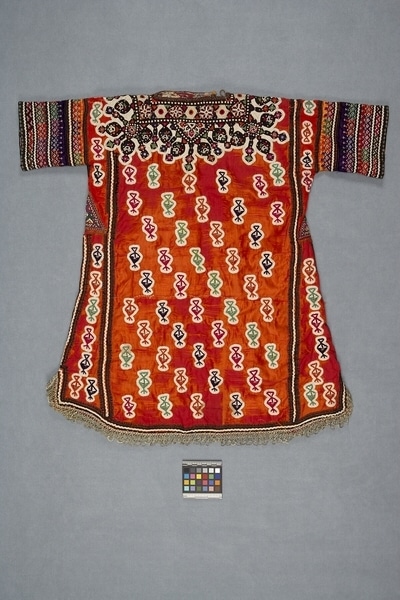Child's Dress Item Number: 1201/15 from the MOA: University of British Columbia


Description
Child’s embroidered dress with off-centre front neckline opening. A densely embroidered panel, trimmed with mirrors, surrounds the neck opening in the front and extends over the shoulders to form a back yoke. There is a large pocket inside the front of the dress that is accessible through the neckline slit; the purple machine printed cotton textile that forms the pocket is visible at the neckline. The flared skirt is embroidered with scattered multicoloured geometric figures on both the front and the back. The orange silk textile of the skirt is heavily damaged, exposing the red cotton underlining. Triangular, embroidered gussets are inserted at the sides, under the sleeves. The round neck opening closes with a loop fastener on the right hand side. Sleeve bands of embroidered textile (orange; purple; rose) are trimmed with sequins, rickrack and braid. The hem is finished with silver metallic braid (3 cm wide). The entire garment is underlined with cotton textile. A label made of off-white cotton textile, printed with a rubber stamp and handwritten with ball-point ink is attached at the neck edge on the back with a loose running stitch.
History Of Use
"Colours of the Indus" refers to this type of garment as a girl’s dress. However, Razia Ahmed states that it is not unusual for boys up to the age of 6 years to wear colourful embroidered clothing like this.
Narrative
This garment was purchased by the owners of Terlingua, a retail shop in Calgary, from an agent or dealer in Kabul, Afghanistan, and exported to Canada from there. The dress was offered for retail sale at Terlingua previous to its acquisition by the Museum of Anthropology.
Iconographic Meaning
The scattered multicoloured geometric figures on the skirt of the dress may be representations of human, animal and vegetative forms.
Item History
- Made in Thando Bula Khan, Sindh, Pakistan before 1982
- Collected during 1982
- Owned by Alan Davidson between 1982 and February 24, 1987
- Received from Alan Davidson (Seller), Ruth Read Bequest (Funding source) and Museum of Anthropology Shop Volunteers (Funding source) on February 24, 1987
What
- Name
- Child's Dress
- Identification Number
- 1201/15
- Type of Item
- dress
- Material
- cotton fibre, silk fibre, silver alloy metal, glass and dye
- Manufacturing Technique
- embroidered, cut, sewn and appliqued
- Overall
- height 74.0 cm, width 77.0 cm
Who
- Culture
- Lohana, Pallari and Burati
- Previous Owner
- Alan Davidson
- Received from
- Alan Davidson (Seller), Ruth Read Bequest (Funding source) and Museum of Anthropology Shop Volunteers (Funding source)
Where
- Holding Institution
- MOA: University of British Columbia
- Made in
- Thando Bula Khan, Sindh, Pakistan
When
- Creation Date
- before 1982
- Collection Date
- during 1982
- Ownership Date
- between 1982 and February 24, 1987
- Acquisition Date
- on February 24, 1987
Other
- Item Classes
- textiles
- Condition
- fair
- Accession Number
- 1201/0015